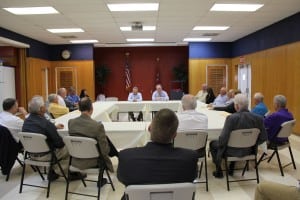Fayetteville Public Utilities (FPU) is moving forward with plans for facility renovations and expansion at the current office location to better serve utility customers.
“During this process, utility rates will not increase,” says FPU’s CEO and General Manager Britt Dye, “and we do not have plans to borrow funds for construction. The decision to expand and renovate our office follows many years of planning and setting aside reserve funds for the construction.”
“For years, we have needed additional office space and improved facilities to better serve the customers of Fayetteville Public Utilities,” Dye adds. “The 2002 utility consolidation successfully streamlined customer service and utility operations, and since then, we have managed to use every available space at our existing location for offices, meeting rooms, storage areas and department operations.”
Among the many concerns of FPU’s current situation is the need to improve security for customer confidentiality. Dye explains that current office space does not adequately accommodate customer privacy or other administrative concerns under the Identity Theft Policy adopted in 2008 to protect all manner of customer account information.
Due to the utility’s limited space for its customer service area, some FPU employees work in open-cubicle offices that offer little or no privacy for handling customer account and financial data. More private office space will allow employees to obtain and discuss sensitive utility account information with FPU customers under the guidelines of the Identity Theft Policy.
Other FPU office employees work in areas originally designed and used for material and file storage and for telecom headend operations. Construction and renovation plans include relocation of these offices and for a dedicated room for Channel 6 productions which FPU currently does not have.
“FPU’s Channel 6 is a vital information resource for our community,” says Dye. “Each day Channel 6 brings the community local programming and educational information as well as promotes and highlights community events. With the proper facilities for interviews and program editing, we can improve the quality of local programming you deserve and depend on from FPU’s Channel 6.”
FPU is also in need of additional storage space for office supplies and materials. Because there is limited storage available now, office forms and materials are currently stored in FPU’s minimally temperature-controlled warehouse facility along with utility construction materials.
FPU’s preliminary building and renovation plans will provide for the needed office space, improve security and customer confidentiality, add temperature-controlled storage areas for supplies and materials and will include an employee meeting area large enough to accommodate all 108 employees at one time for training and all-employee meetings. FPU also plans to make the meeting area available to the community for meetings and training.
“Our opportunity to purchase the two adjoining property lots on Market Street near FPU’s main office helped put our plans in motion,” says Dye. “Since that time, we have envisioned ways to better serve our customers. Our board is very supportive of the building plans, and we are working together to improve FPU and provide for future growth of the utility and the services we offer.”
“Having the necessary tools and equipment to perform our jobs is important to our success,” he adds. “We strive to be leaders in the utility industry and in our community. Our goals are to offer additional services to our customers like advanced technology, more payment options, improved communications, improved customer account security and faster, more convenient customer service. But in order to offer these enhanced services, we need the facilities that will support all that we are capable of offering and all that our customers deserve from their utility provider.”
FPU estimates the construction phase will take a year or longer to complete once a design is approved and construction begins.
A large part of the existing Fayetteville Public Utilities’ building at 408 West College Street was built in the early 1940s. The FPU facility has undergone a handful of additions over the past few decades as the utility has evolved with the most recent being the 2007 expansion of the drive-thru payment area and customer parking lot. Prior to that, FPU’s last administration building renovation and addition was in 1988-1989 when the existing administration and customer service offices were built.




